Delphi Digital: The Web3 Gaming Guild at a Turning Point
Title: Gaming Guilds Update
Author: Jayden Andrew, Delphi Digital Analyst
Compiled by: Overnight Porridge
## Introduction
For crypto investors, holding gaming guild tokens in 2022 has been a painful experience. Each token compared in this report has dropped over 80% this year. Of course, many crypto subfields have been hit hard recently, but gaming-related tokens have felt the full wrath of the relentless bear market. This raises the question: do crypto gaming guilds have product-market fit in the absence of hyper-growth P2E games?
If we define guilds strictly as "P2E scholarship providers," the answer may be no. However, despite many guilds being cash-strapped and the market environment being bleak, they still retain tens of thousands of members with varying degrees of loyalty. For those fortunate enough to find themselves in this situation, the poor sentiment surrounding profitability and the concurrent bear market does not mean the game is over. However, it does mean that the surviving guilds must embody "pivot," or at least change direction if they truly want to play the long game in crypto gaming.
In this report, we cover six gaming guilds, focusing on their market performance this year, financial health, and how they are adapting to the evolving crypto gaming landscape.
## Comprehensive Data Comparison
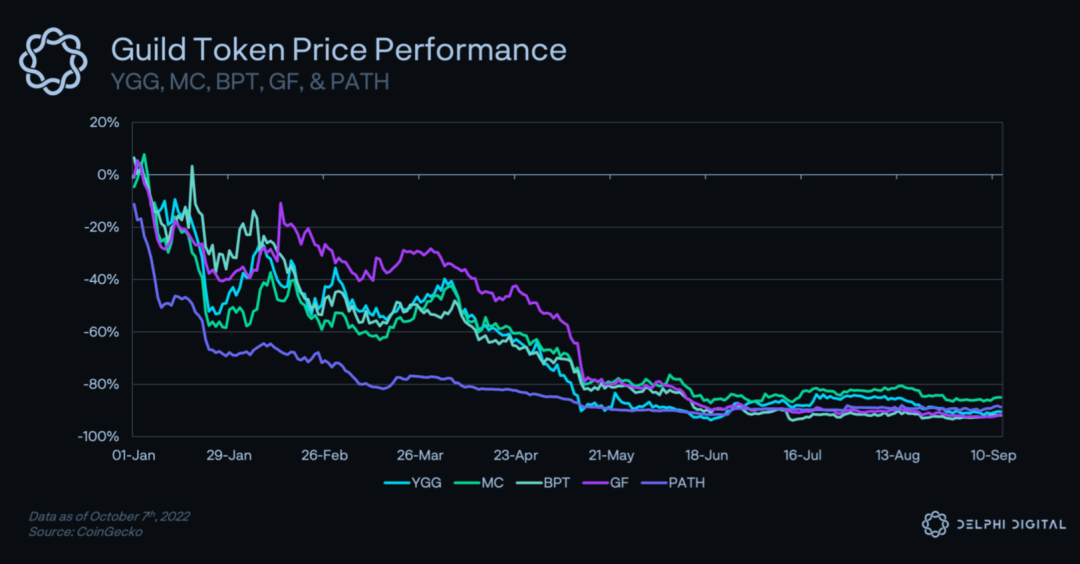
The table below lists the positive confrontations of each gaming guild regarding shared features and unique functionalities compared to other guilds.
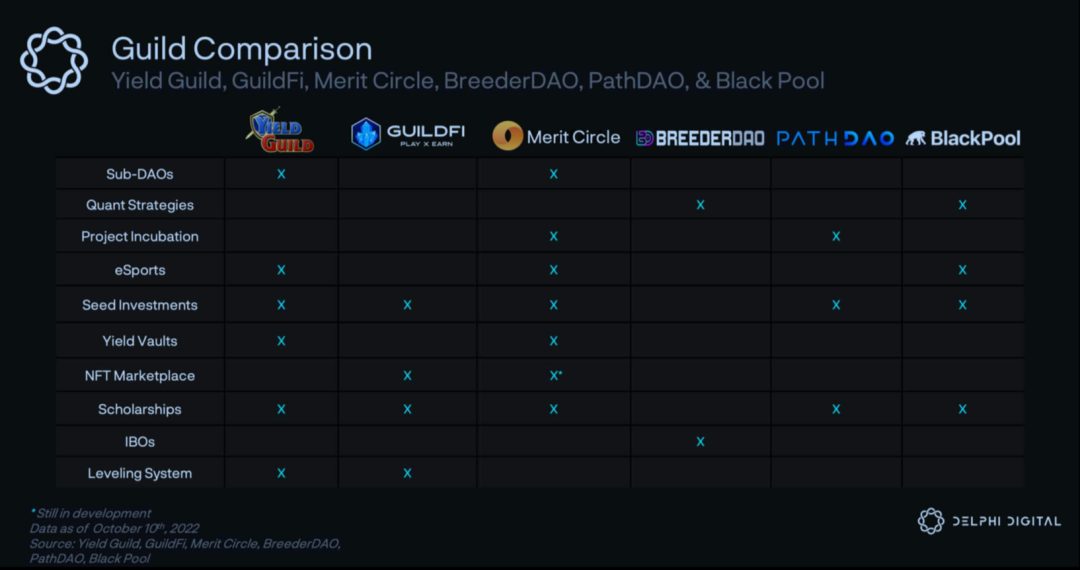
These guilds share some common fundamental characteristics. In a practical sense, a guild is a group of individuals formed around shared interests, values, and goals to achieve common benefits for its members. In the crypto gaming industry, games are clearly their focus. Their differences lie in the specific features and strategies they adopt—some of which are listed in the table above.
The most common feature is the scholarship program, which all mentioned gaming guilds provide except for BreederDAO. This makes sense, as crypto gaming guilds have historically focused on P2E and scholarship models. However, this situation is slowly changing, and we are likely to see a gradual shift in the products offered by guilds. Another commonly adopted strategy among most guilds is seed investment. Interestingly, gaming guilds are increasingly becoming pseudo-venture capital (VC) firms, investing in early-stage gaming projects to help support the industry and, of course, achieve profitability.
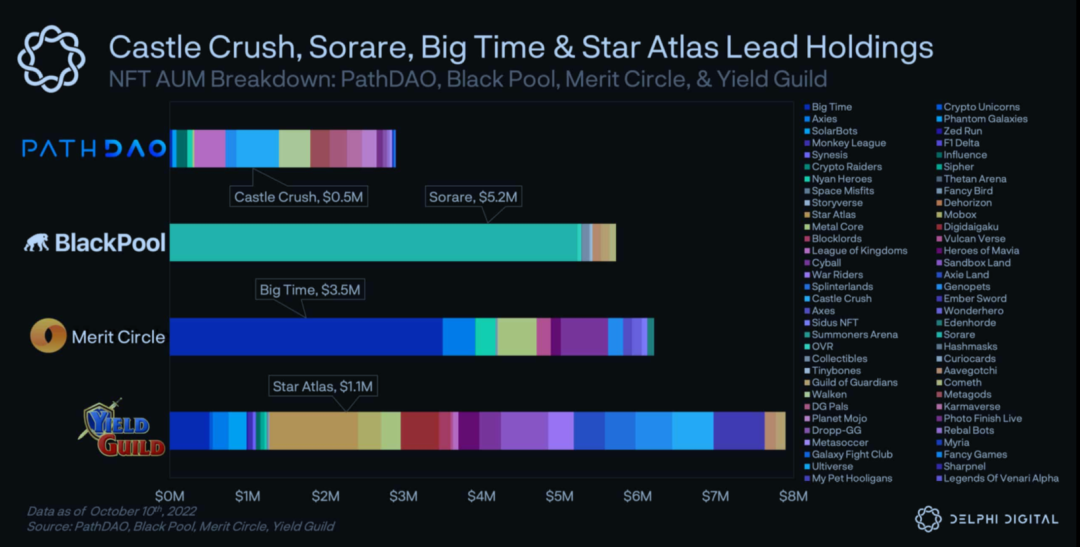
Comparing the current guild NFT AUM (above) with nearly a year ago (below), we can draw some interesting observations. The two most notable guilds are BlackPool and Yield Guild—frankly, both are in bad shape. Since our last observation, both guilds' NFT portfolios have taken a hit.
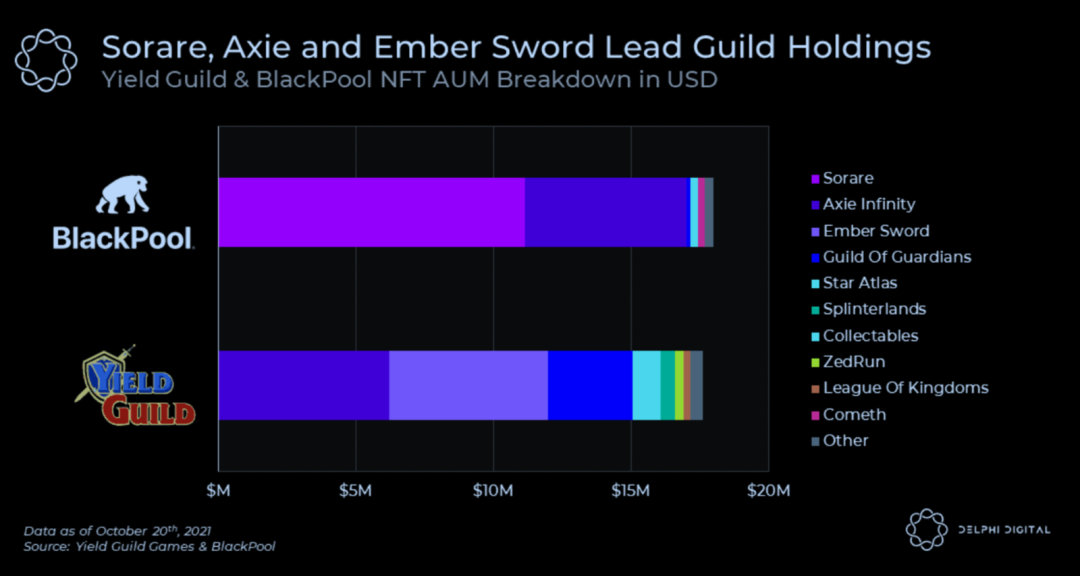
Given the NFT market and the broader ongoing severe macro environment this year, this is not surprising. Another observation we can make is the change in portfolio weightings for the two guilds. Notably, compared to last year, the proportion of Axie Infinity in both guilds' portfolios has decreased significantly.
While not entirely absent, Axie has shifted from being the second-largest holding in BlackPool and the largest holding in Yield Guild to a relatively insignificant position.

This year, the total assets under management of gaming guilds have generally taken a hit, with Yield Guild, GuildFi, and Merit Circle decreasing by 57.3%, 23.6%, and 7.5%, respectively. Despite unfavorable market conditions, Merit Circle has managed to maintain its AUM at an impressive level. Notably, Yield Guild is the only crypto gaming guild with an AUM higher than the funds it initially raised (although it has the largest percentage drawdown year-to-date). More information on fundraising can be found in the chart below.
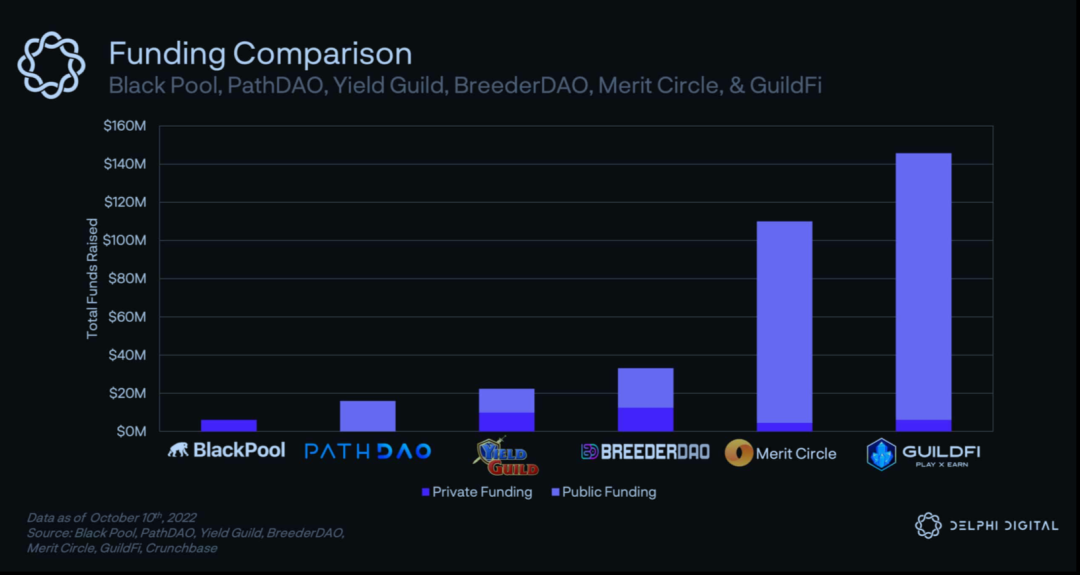
As you can see in the table above, there are significant differences between private and public fundraising for gaming guilds in this comparison. BreederDAO has raised the most private funds, while GuildFi has raised the most public funds. One subtlety to keep in mind is that these guilds raised funds on different dates (i.e., at several different stages of the bull market cycle). This means that the substantial variations in funding are more indicative of the market temperature at the time of fundraising than any real insight into the quality differences between guilds.
However, it does point us toward which gaming guilds should have substantial treasury funds unless investor capital management is severely mismanaged. Gaming guilds fortunate enough to fit this description of being well-capitalized should have enough cash to weather tough times, and if they put their eggs in the right baskets, they will emerge stronger on the other side.
Notably, although Yield Guild has raised relatively less capital, it boasts impressive data metrics in terms of community size (as shown below). Having a first-mover advantage undoubtedly helps achieve this.

In the recent bull market, the term "community" has somewhat become a buzzword. In other more casual contexts, "community members" have also become synonymous with "bag holders." However, community is not just a buzzword or a joke about portfolio losses. Over time, it has become increasingly clear that communities can be powerful entities capable of achieving tangible results through collective action. The potential of communities remains untapped, and when unified and focused on specific goals, they become a true expression of the cliché "numbers advantage."
Player liquidity, the concept that guilds can concentrate some community members on new games, has the potential to prove this point. The idea is that this allows players to get a head start in new games and provides valuable early users to help them grow. In practice, it remains unclear how effective this is outside of hyper-growth P2E game models. At the very least, for early games, gaining the attention of a gaming guild community is not a bad thing.
A non-crypto specific example of this ability is a fitness influencer launching a supplement. By leveraging their fan base, the fitness influencer can guide a consumer-facing business, giving them a significant advantage compared to ordinary people without a fan base.
So which gaming guild has the strongest community? That's a good question. In the table above, you can see the data for each guild's Twitter followers, Discord members, Telegram, token holders, and NFT holders. As we mentioned in the fundraising section, Yield Guild has some impressive community statistics. It ranks at the top in all aspects except for Telegram data.
- Lower engagement—becoming a Twitter follower
- Higher engagement—becoming a Discord/Telegram member
- Higher engagement—becoming an active Discord member/DAO participant
- Highest engagement—purchasing tokens/NFTs
Another consideration is where and how members engage with the guild. It can be argued that different platforms elicit different levels of engagement. What does this mean? Think of it this way: if you've worked in the crypto space for a while, you'll find that your experience with a project's community varies significantly when you cross the chasm from Twitter to Discord. The noise on Discord is lower, discussions are more focused, and there is often more direct contact with the founders. Additionally, becoming a member of a Discord server is generally more challenging than simply following the project on Twitter. You typically need to read a brief list of server rules and click a few options. Of course, this isn't that hard, but it's somewhat more difficult than just clicking the Twitter follow button. These factors may seem trivial, but they can lead to differences in member engagement experiences across platforms.
## Yield Guild
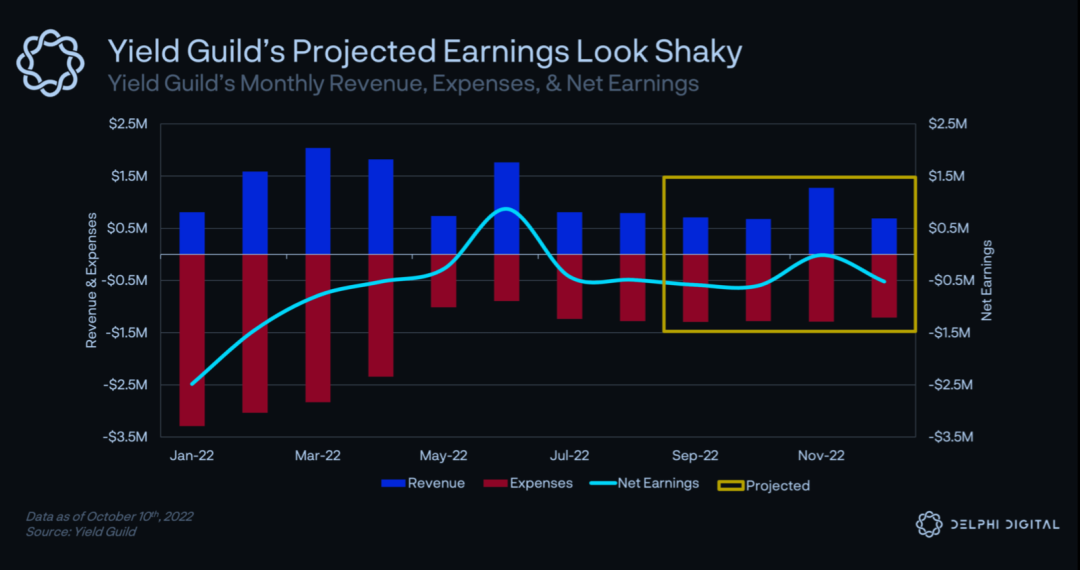
Although Yield Guild's net profitability has been improving throughout the first half of 2022, its current earnings do not paint a picture of health and prosperity. Aside from June 2022, no other month has been net profitable for the guild this year. There is little hope for Yield Guild's forward-looking earnings forecast before the end of the year. At best, this can be interpreted as an economic slowdown leading to stagnation in net profit margins. In the worst-case scenario, the guild may see profits continue to decline into the new year. This undoubtedly calls into question the viability of Yield Guild's current strategy.
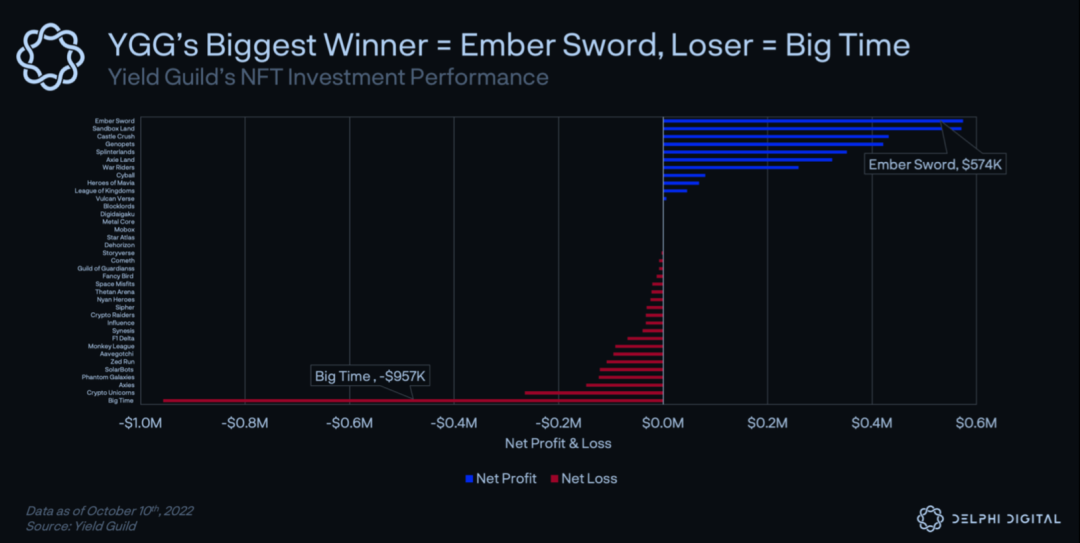
Yield Guild's best-performing NFT investment is Ember Sword. In contrast to Merit Circle, Big Time is actually Yield Guild's worst-performing NFT investment.
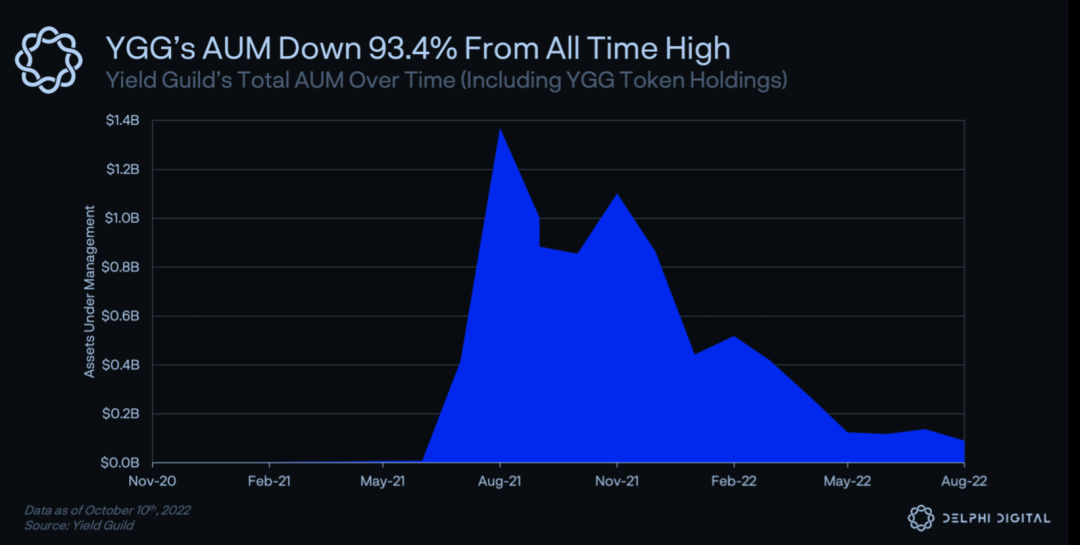
As shown in the above chart, the total asset value managed by Yield Guild saw a significant boost due to the launch of the YGG token in July 2021.
This is certainly in the context of YGG appreciating significantly after its release. However, the positive impact on the total AUM value during the rise will proportionally turn into negative impacts during the decline. With the YGG token down 96.9% from its all-time high, it is not surprising that Yield Guild's total assets under management have also decreased by 93.4% from their peak.
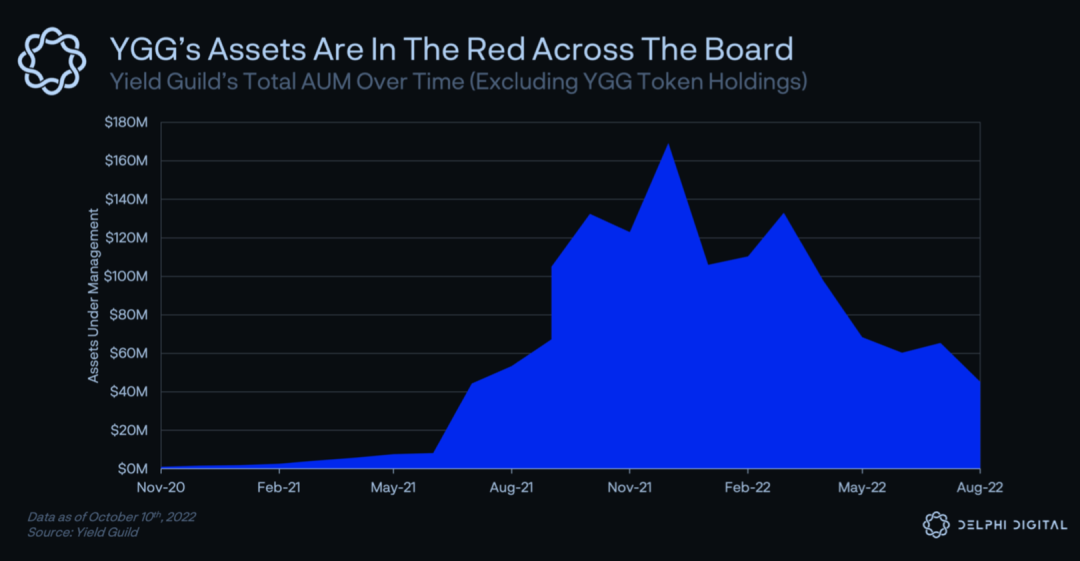
In the chart above, we see Yield Guild's total assets under management over time (excluding the YGG held in its treasury). As you would expect, the total value is significantly lower over time than the value that includes the token. Interestingly, compared to the historical high of $169 million set last December, the valuation has still significantly decreased. Currently, Yield Guild's total assets under management are approximately $45 million, having shrunk by 73.3%. This means that not only has the YGG token held by Yield Guild suffered significant losses, but their NFT and other token investments have also taken a hit. In contrast, Merit Circle has a considerably substantial total assets under management, as we further emphasize in this report.
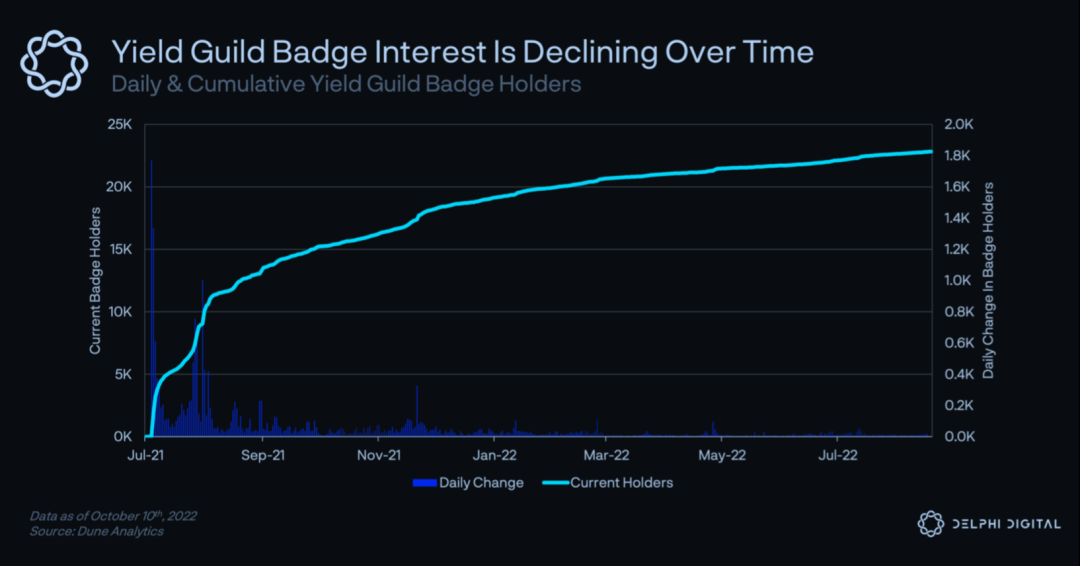
We previously outlined the value of community. While snapshot data can provide some insight into the size of the guild community, it is also helpful to evaluate the data over time to add some context. In light of this, we can see the number of holders of Yield Guild over time in the chart above. On the positive side, the total number of holders has increased over time, indicating that this level of community engagement (investing their own money) has grown among guild members.
On the downside, the speed of new holders has significantly slowed over time, with very little growth, which is not ideal. This indicates that the growth of community members willing to make financial investments has actually slowed over time. It suggests that overall interest in joining the guild has greatly diminished, particularly as participants willing to make financial investments.

The number of Discord members in Yield Guild has declined from the rapid upward trend seen in 2021. From a peak of 113,800 Discord members in April, it has dropped to 81,000 by August. Several factors may have contributed to this loss of members. In January of this year, Yield Guild's Discord server was hacked, potentially leading to a large number of users being kicked from the server. Throughout 2022, Axie Infinity made several changes to its game economy, some of which directly reduced players' SLP earning potential. In addition to losing income due to economic design changes, SLP has also been ravaged by the bear market. The token has dropped 99.2% from its all-time high of $0.39 in July 2021. Most importantly, guilds like Yield Guild are increasingly publicly moving away from the "P2E" scholarship model and shifting their focus to esports games. When we consider this combination of factors, the decline in Yield Guild's Discord membership becomes less mysterious.
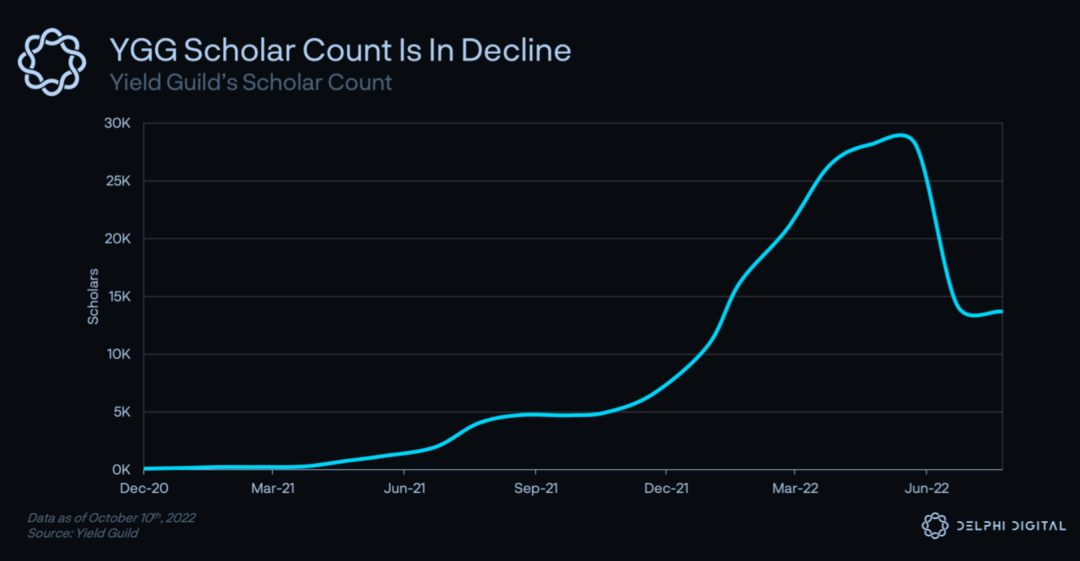
The above chart shows the number of scholars in Yield Guild over time. As you can see, there was a significant drop in the number of scholars between May and July, supporting the theory outlined above.
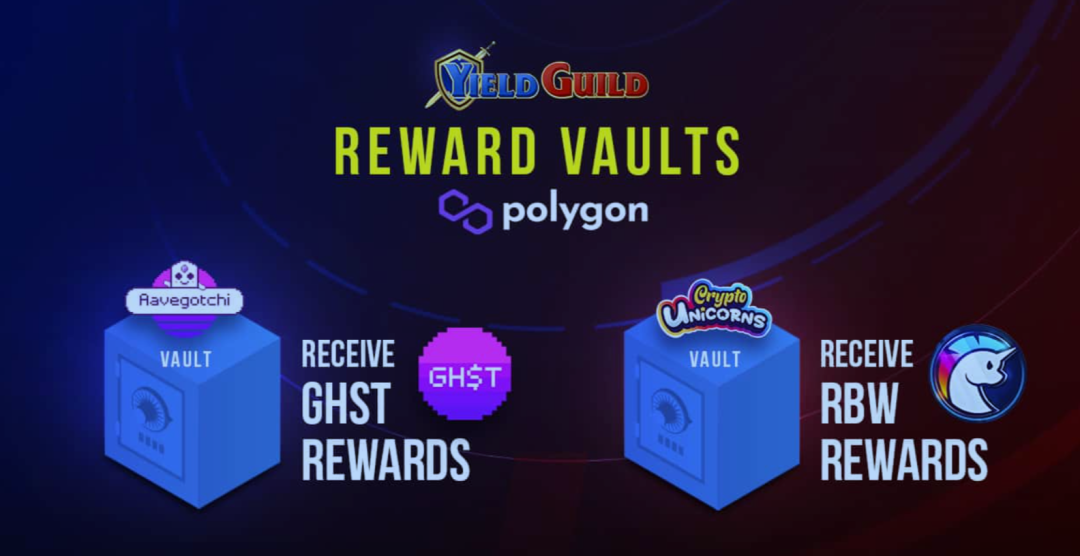
YGG holders with the YGG guild badge can stake their tokens in either of the two YGG reward vaults on Polygon (for up to 90 days) to earn corresponding rewards in the form of P2E tokens. Yield Guild chose to launch the reward vaults on Polygon to lower the barriers to participation and allow participants to retain more rewards rather than pay gas fees.
Mission: Unlock Achievements > Mindless Participation
Yield Guild is beginning its second season of the Guild Advancement Program (GAP), a community token distribution protocol driven by achievements that rewards YGG members for providing value to the guild through high-quality contributions.
The first season of GAP consists of 45 achievements designed to incentivize certain behaviors to help grow the guild. Additionally, it allows members to build their metaverse resumes. It achieves this by rewarding participants with NFTs and YGG tokens for completing specific tasks, which both reward participants' efforts and distinguish outstanding contributors within the guild, opening up more opportunities for them in the future.
Yield Guild describes GAP as a return to the fundamental concept of guilds in medieval times, where skilled merchants used their skills to improve the local environment and enhance the guild's reputation.
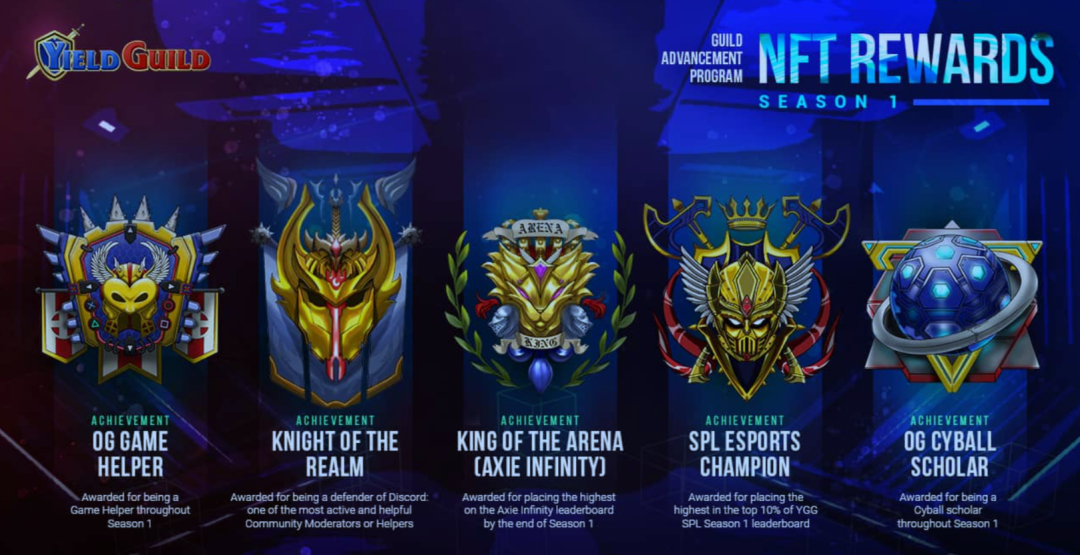
Ignite the Competitive Spirit
Yield Guild is one of several guilds moving toward esports games. The leaderboard shown in the chart below showcases high-achieving guild members, aiming to foster healthy competition within the guild.
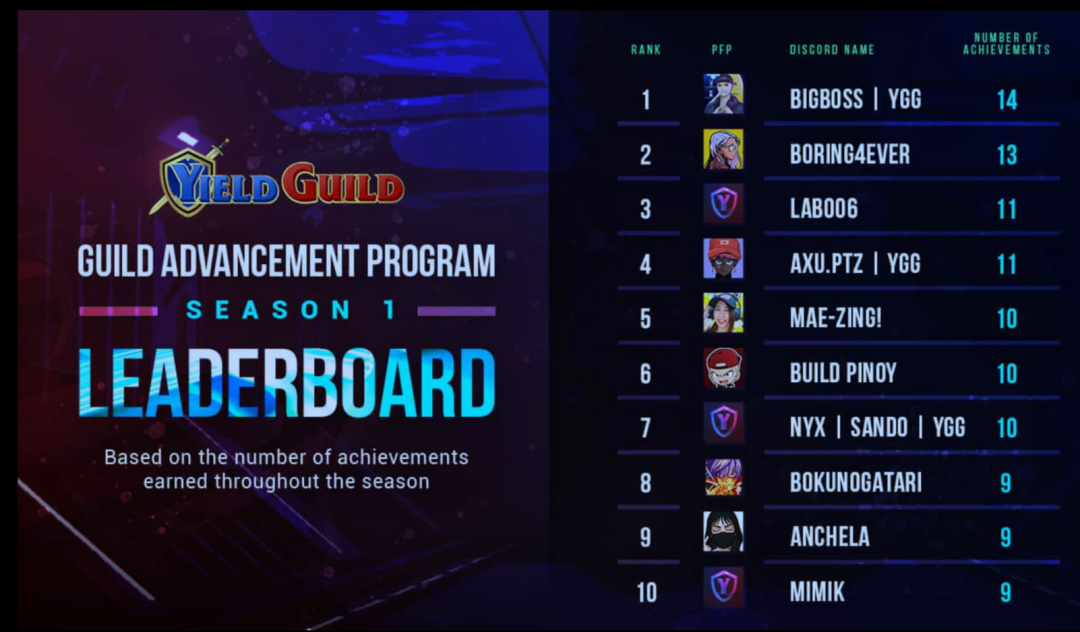
## GuildFi
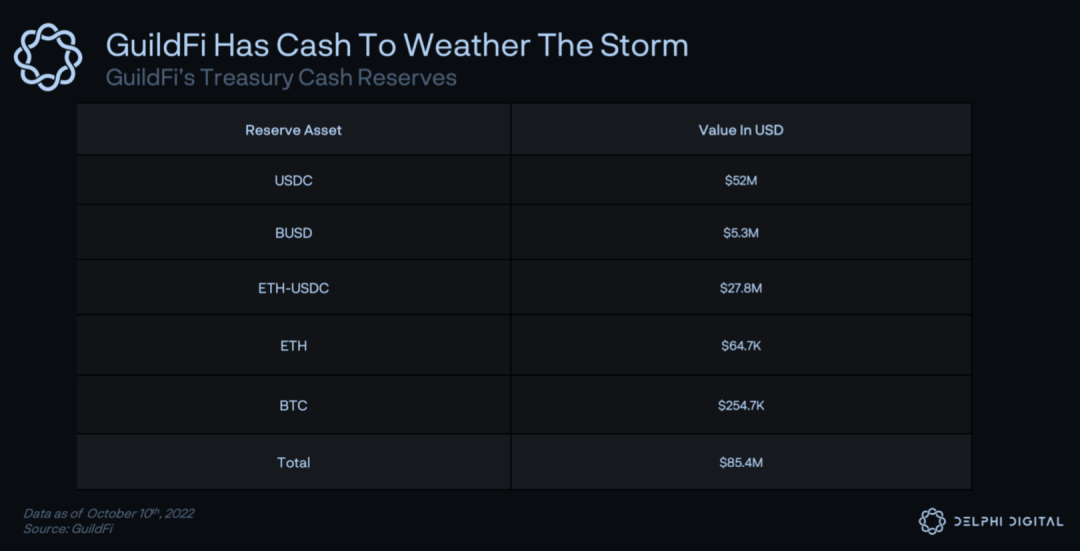
GuildFi's treasury has the largest cash position among all the guilds in this report. This does not include other held tokens, seed investments, and NFTs, with the total cash value of its treasury being approximately $85.4 million. Given the current bear market, such a substantial amount is clearly a tangible advantage for the guild.
GuildFi ID
GuildFi describes its GuildFi ID as a metaverse passport. The idea is that it links all your gaming accounts to ensure your achievements are recognized across the metaverse. Like a regular passport, it allows you to access places and experiences that you cannot without it. This includes products within the GuildFi ecosystem.
How players can register for a GuildFi ID:
- Visit the GuildFi website;
- Create an account using an email;
- Connect their account to Discord and Metamask;
Proof-of-Play (PoP)
Proof-of-Play (PoP) is where players earn GXP as experience points from their gaming participation and activities on GuildFi. Players are eligible for these GXP as long as they register for a GuildFi ID. Players can earn GXP by participating in games and tasks offered on GuildFi, which can lead to various benefits ranging from token rewards to NFT Metadrop allocations. GXP will also help with the upgrade system and determine player rankings.

Players can earn GXP by completing tasks, playing partner games, participating in GuildFi's scholarship program, and utilizing GuildFi's features. GXP benefits players by allocating NFTs from Metadrop launchpad events, other free NFT drops, early access to games, and potential GuildFi rewards.
Metadrop Launchpad
GuildFi offers special NFTs and early token investment opportunities from its partners. Allocations depend on players' participation in the metaverse. The idea is that games can reward the right players upon release. Asset allocations are based on their GXP/participation in games (Proof-of-Play)/GF holdings.
## Merit Circle
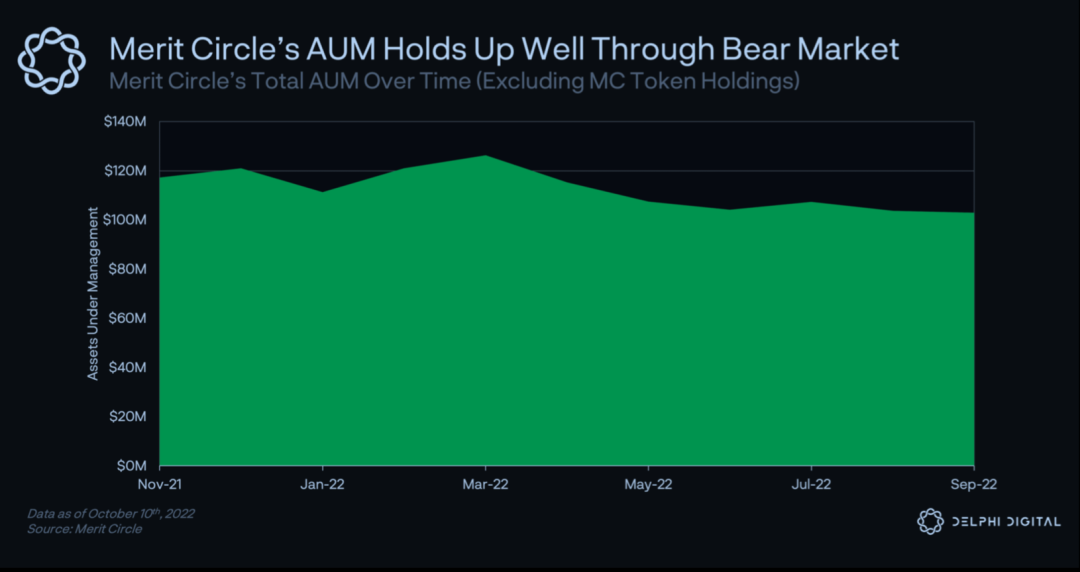
Over time, Merit Circle's total assets under management have remained strong, especially amid the prolonged downturn of the bear market. This reflects Merit Circle's effective management of treasury funds, which, of course, has had a positive impact on its guild. This gives Merit Circle a significant financial advantage compared to cash-strapped guilds. This is particularly true as the winds inevitably shift toward more favorable financial markets. Before that, it provided Merit Circle with ample funds to weather the current storm.
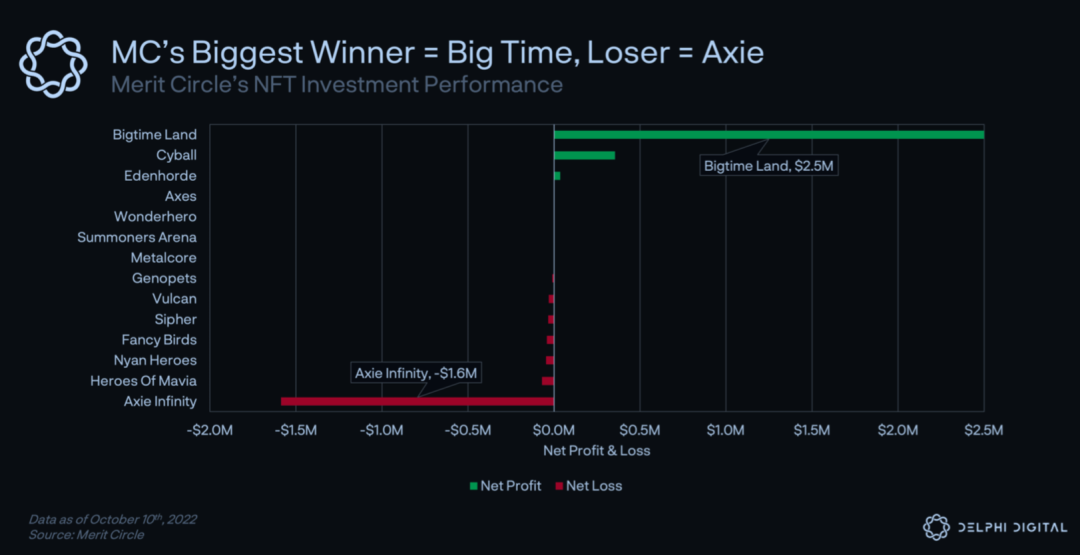
Visualizing it, Merit Circle's NFT investment performance seems to embody the Pareto principle. Most of the total profits and losses can be attributed to a few investments. In this case, Merit Circle's biggest winner is Big Time land. Similarly, most of Merit Circle's losses can be attributed to a few investments. In this case, the culprit is Axie Infinity.
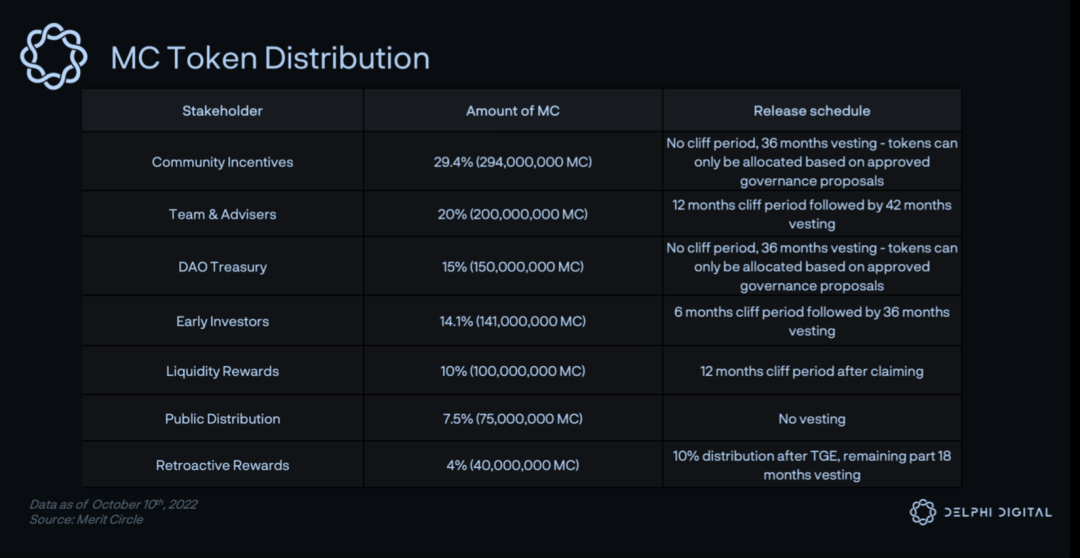
MIP-7: Token Burn
MIP-7 is a proposal to the Merit Circle DAO regarding the operations, structure, and strategy of Merit Circle's investments.
MIP-7 was proposed by Sad Cat Capital and voted on and implemented in December 2021. Through MIP-2, the DAO began to formally establish a framework to invest a significant amount of resources obtained from its treasury into tokens, NFTs, stablecoins, and yield farming businesses.
MIP-6 further advanced this by setting parameters that the DAO could use to reduce its investment risks. This took a multifaceted approach, as it was necessary to find a balance between returning profits to the DAO and maintaining a level of productive assets used for P2E revenue generation alongside partnered games.
MIP-7 expands on the previous mission by combining Merit Circle's investment framework with the sustainable future vision of the Merit Circle DAO. This is dual-purpose—besides increasing the value of MC, it also promotes the growth of the DAO itself.

The mission aims to create a more transparent and structured way to allocate the DAO's realized profits, which includes:
- 20% of profits returned to the treasury in USDC;
- 5% of profits returned to the treasury in crypto assets (mainly ETH and WBTC);
- 60% of profits used to support MC prices below market value by 10%-35%;
- 15% of profits used to buy back MC and send to 0x000000 (burn).
As of now, how much MC tokens have they bought back and burned? Let's take a look at the chart below.
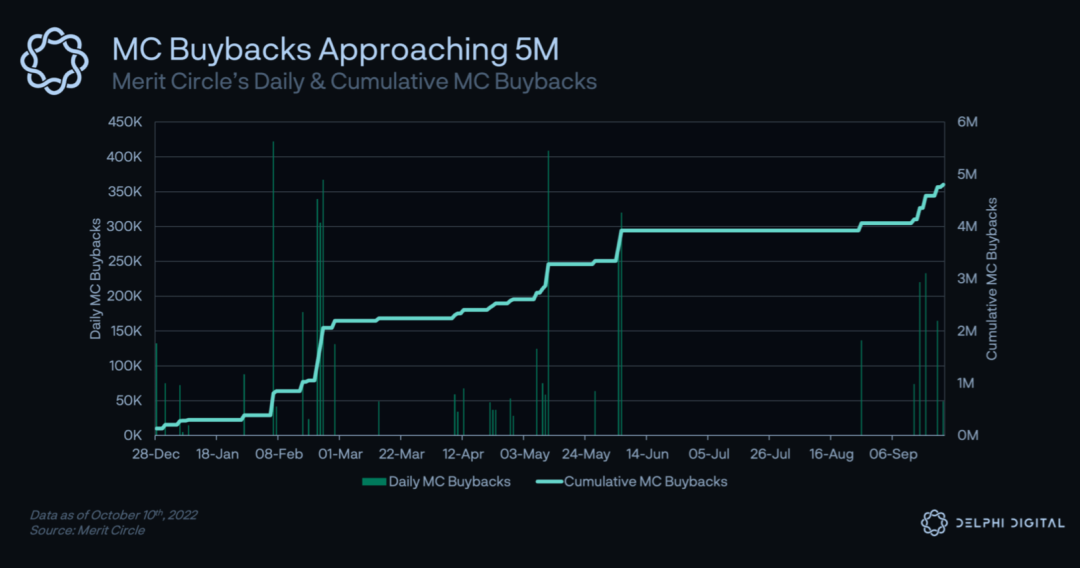
As you can see in the two charts, the buyback and burn amounts are quite sporadic, but they are starting to reduce the supply of MC. The total number of MC tokens bought back (above) is close to 5 million. The total number of MC burned (below) is close to 120 million. This amounts to 12.5% of the total diluted supply purchased or burned so far. While this is a tangible figure, the net circulating supply has increased during the same period. Unless Merit Circle's revenue increases significantly, leading to more buybacks and burns, MC will remain in an inflationary state for the foreseeable future.
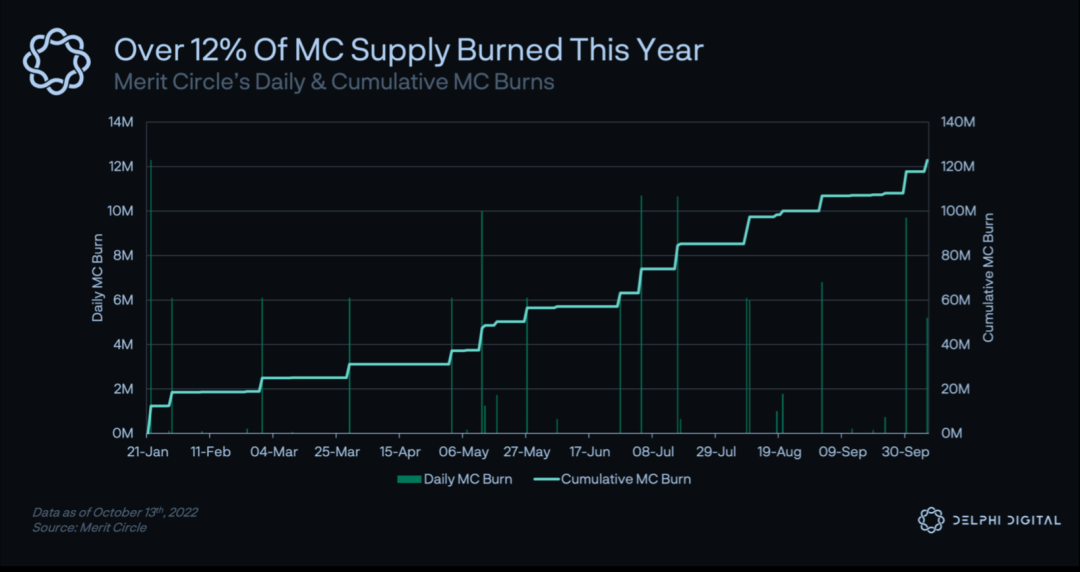

Sphere is Merit Circle's dedicated NFT marketplace for gaming assets. Their goal is to create a marketplace best suited for gaming NFTs to compete with products like OpenSea, which they believe is less suitable for gaming assets due to its lack of specificity. With markets like OpenSea handling billions of dollars in transactions monthly, Merit Circle is leveraging Sphere to enter a large market. MC will play a significant role in this marketplace, especially regarding fees. Sellers pay a 2.5% fee per transaction, paid in ETH. The collected ETH will be used to buy back MC from the secondary market and return it to sellers. This mechanism reduces sellers' fees, as 50% of the total fees paid will be reimbursed in liquid MC. This model creates a continuous buying flow for MC while incentivizing the use of Sphere in other markets. Sphere is still under development, but Merit Circle has indicated that it was nearly ready back in July, so it may be worth keeping an eye on in the near future.
## BreederDAO
Metaverse (P2E) Factory
BreederDAO is quite unique compared to other guilds in this report, as their business model has never directly offered P2E scholarship programs. Instead, they largely position themselves as game NFT suppliers. They provide in-game assets, such as characters with specific advantageous traits, to guilds like Yield Guild.
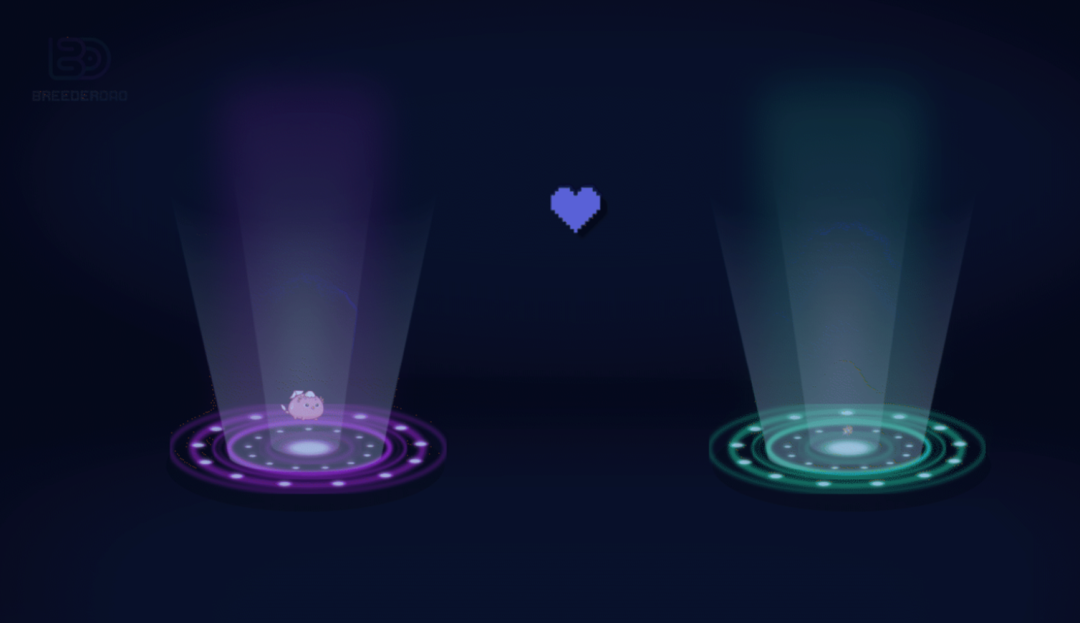
Playcore
Playcore is a data dashboard focused on crypto games developed by BreederDAO. It provides real-time data on metrics such as game token minting, burning, and net supply changes, as well as market statistics like average floor price, sales price, and trading volume. It also offers nuanced player data, such as the number of new, returning, active, and dormant players over time.
For a deeper dive, check out our previous research report on BreederDAO.
## PathDAO
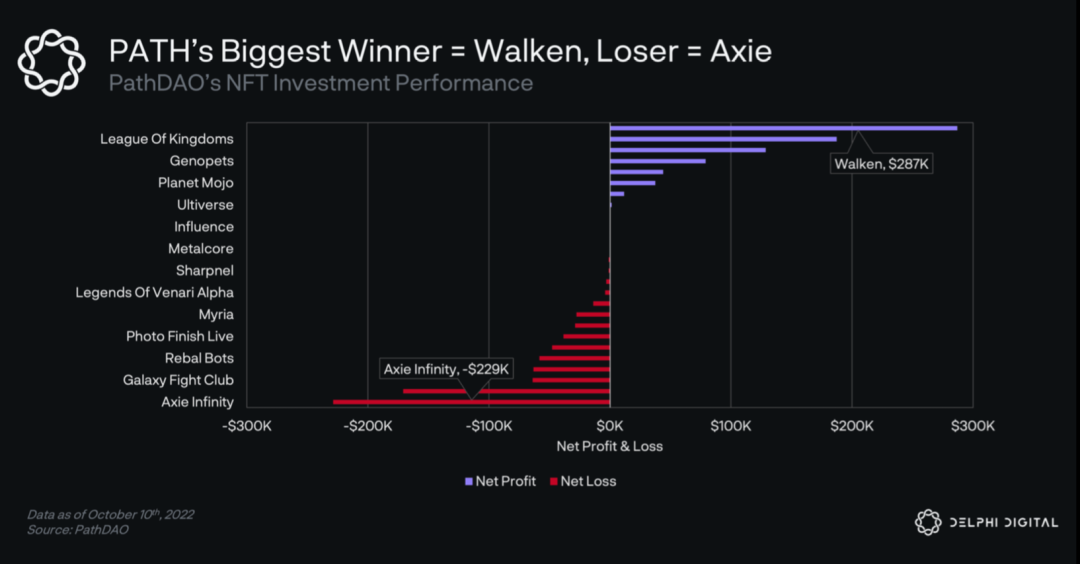
PathDAO's best-performing NFT investment is League Of Kingdoms. Like Merit Circle, their worst-performing NFT investment is Axie Infinity.
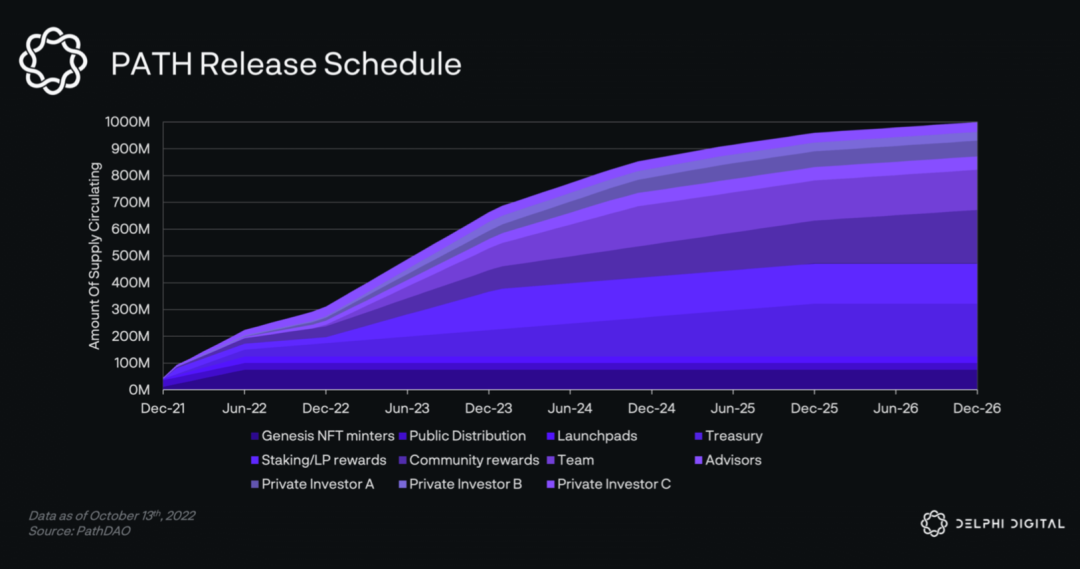
PIP-6B: PATH Buyback
Similar to Merit Circle, PathDAO has introduced a buyback system based on guild earnings. According to PIP-6B, realized profits will be used for PATH buybacks and Ether procurement, divided into the following parts:
- 20% of profits returned to the treasury in USDC;
- 5% of profits returned to the treasury in crypto assets (mainly ETH and WBTC);
- 15% of profits used for market buybacks of PATH;
- 60% of profits used to strongly support PATH tokens below market value by 10%-35%.
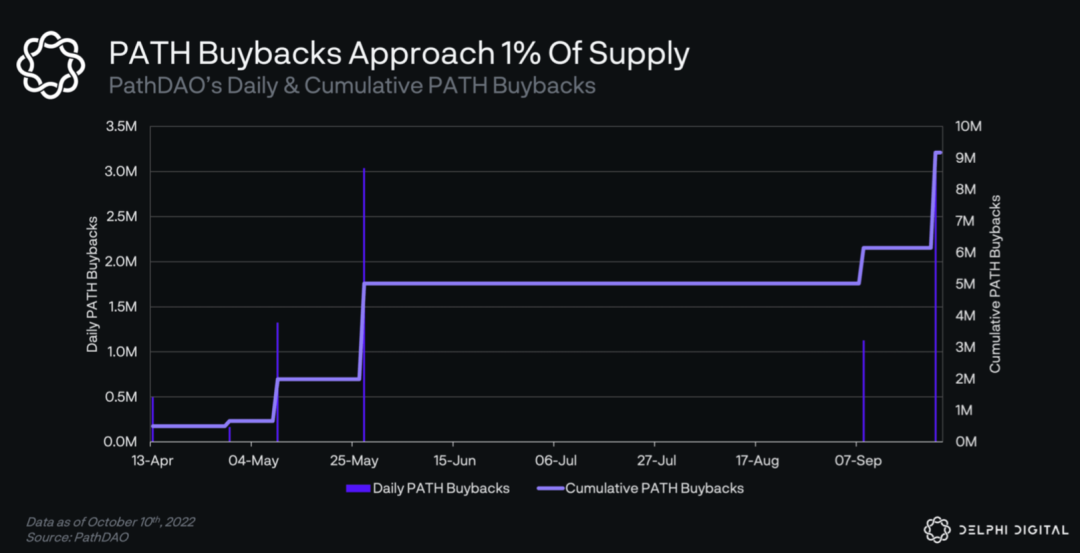
As of now, although PathDAO's buyback and burn data is not as impressive as Merit Circle's MC, it has successfully bought back nearly 1% of the total supply of PATH.
## BlackPool
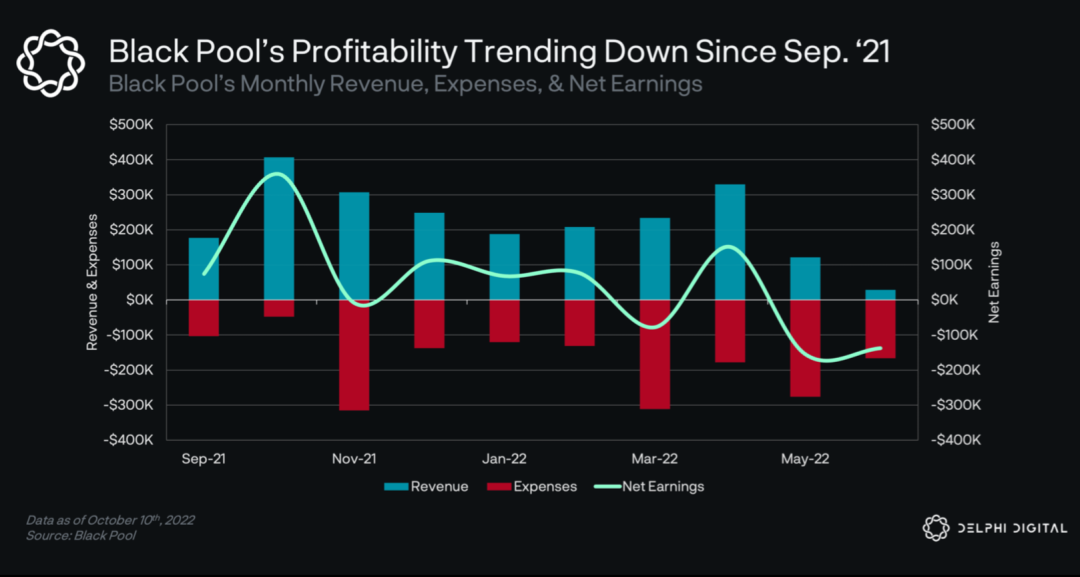
Like Yield Guild, BlackPool's earnings look dismal. Since October 2021, the guild's monthly net income has been on a downward trend. Notably, the last month of the second quarter was BlackPool's worst net income month ever.

According to the data, BlackPool seems to have underperformed in several areas over the past few years. As we previously highlighted in the community comparison table, despite being one of the oldest crypto gaming guilds, it ranks last in most cases. As we see in the previous chart, BlackPool's earnings have been heading in the wrong direction since September 2021. Now looking at the chart above, it is clear that BlackPool's NFT portfolio has also performed poorly throughout the year.
## Final Thoughts
Crypto gaming guilds are at a turning point, facing the challenge of how to move forward after the "P2E" model becomes outdated. Those guilds with substantial treasury balances are in a favorable position, providing them with the runway they need to determine their next investment steps.
Yield Guild has just launched its second season of GAP, shifting its focus toward esports. In contrast, GuildFi is the cash king, boasting an impressive $85.4 million treasury reserve, providing ample momentum for further development of its gamer dashboard. Merit Circle is developing its gaming NFT marketplace, Sphere, aiming to compete with platforms like OpenSea. It is certain that each guild in this report has been severely impacted by the bear market. Token prices and the total value of managed assets are declining, and earnings have not improved. What remains uncertain is which gaming guilds we will see on the other side of this difficult period. It depends on the direction they take moving forward and how much funding they ultimately need to support them.










